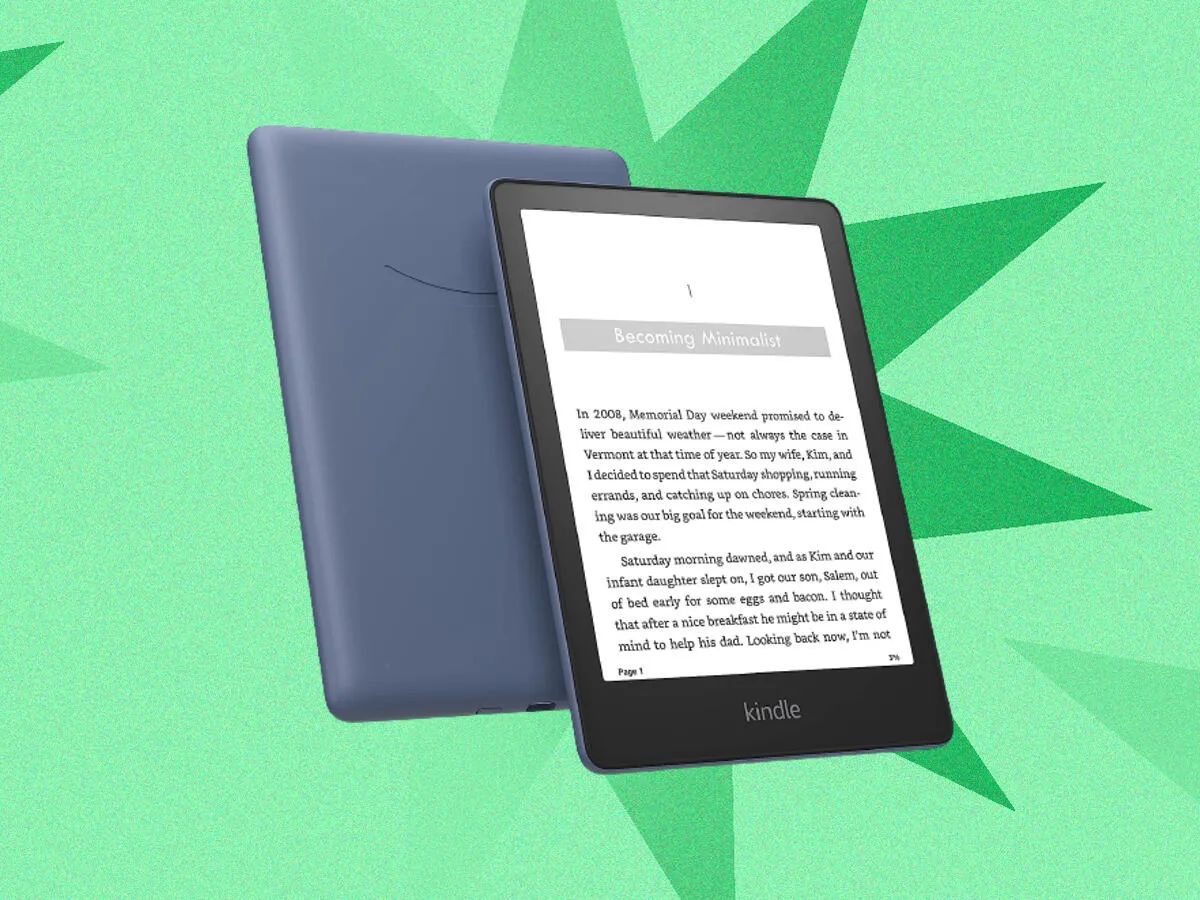Introduction
Are you passionate about cooking and have a treasure trove of delicious recipes just waiting to be shared with the world? Writing an eBook cookbook is the perfect way to showcase your culinary expertise and reach a wider audience. Whether you’re an aspiring chef or a home cook with a penchant for creating mouthwatering dishes, an eBook cookbook offers an opportunity to share your recipes, cooking tips, and personal stories with others.
In this comprehensive guide, we will walk you through the process of writing an eBook cookbook from start to finish. We’ll cover everything from choosing your niche and target audience to designing an attractive cover and formatting your eBook for publishing. By the end of this guide, you’ll be equipped with the knowledge and tools necessary to create a beautifully crafted eBook cookbook that captures the hearts and taste buds of your readers.
Writing an eBook cookbook not only allows you to showcase your culinary skills but also presents an opportunity to build your personal brand and generate income. With the rise of digital platforms and the increasing popularity of eBooks, self-publishing has become more accessible than ever. By following the steps outlined in this guide, you’ll be well on your way to creating a valuable resource that can be shared, promoted, and monetized.
So, whether you’re a seasoned chef looking to expand your digital presence or a cooking enthusiast eager to share your favorite recipes, let’s dive into the exciting journey of writing your very own eBook cookbook!
Step 1: Choose Your Niche and Target Audience
The first step in writing an eBook cookbook is to narrow down your focus by choosing a niche and defining your target audience. This is an important step because it helps you tailor your content to meet the specific needs and interests of your readers.
Start by considering your own cooking style and expertise. Are you a master baker with a knack for creating delectable desserts? Or perhaps you specialize in vegan or gluten-free cooking? Identifying your niche will not only make your eBook cookbook stand out in the crowded market but also allow you to showcase your unique skills and knowledge.
Once you’ve chosen your niche, it’s essential to define your target audience. Think about the type of readers who would benefit from your cookbook. Are you targeting busy working professionals in need of quick and easy weeknight meals? Or are you catering to health enthusiasts looking for nutritious and flavorful recipes?
Researching your target audience is crucial as it helps you understand their needs, preferences, and pain points. Consider conducting surveys or engaging with your potential readers on social media platforms to gather valuable insights. This information will guide your content creation process and ensure that your eBook cookbook resonates with your target audience.
Additionally, keep in mind the level of cooking expertise your target audience possesses. Are you writing for beginner cooks who need step-by-step instructions, or are you targeting experienced home cooks who are looking to enhance their skills? Adapting your writing style and the complexity of your recipes to match your readers’ skill level will create a more engaging and user-friendly experience.
Remember, choosing a niche and understanding your target audience are the foundations of a successful eBook cookbook. By catering to a specific audience, you’ll be able to create content that genuinely connects with your readers and meets their culinary needs and aspirations.
Step 2: Research Your Market and Competitors
Before you dive into the writing process, it’s crucial to conduct thorough research on your market and competitors. This step will give you valuable insights into what’s already available in the eBook cookbook space and help you differentiate your content.
Start by exploring existing eBook cookbooks in your chosen niche. Read reviews, analyze their table of contents, and examine their cooking styles and recipe formats. This research will give you an understanding of what has already been covered and what unique angle or perspective you can bring to your eBook.
Identify your competitors and study their strengths and weaknesses. Look for gaps or areas that you can fill with your expertise or innovative approach. By offering something new or delivering information in a more engaging way, you’ll attract readers who are looking for fresh content in your niche.
Furthermore, analyze the success factors of the bestselling eBook cookbooks in your niche. Study their marketing strategies, cover designs, and promotional tactics. Take note of what resonates with their audience and identify ways to incorporate successful elements into your own eBook cookbook.
It’s also important to consider pricing and monetization strategies in your market research. Evaluate the current price range of eBook cookbooks in your niche and determine a competitive yet profitable price point for your work. Look for opportunities to offer additional value through bonuses, recipe bundles, or exclusive content that sets your eBook apart.
By conducting thorough market research and understanding your competitors, you’ll be better equipped to position your eBook cookbook uniquely. This knowledge will guide your content creation, marketing efforts, and overall strategy, allowing you to create an eBook that stands out from the competition and appeals to your target audience.
Step 3: Plan and Organize Your Content
Once you have chosen your niche and conducted market research, it’s time to plan and organize the content for your eBook cookbook. A well-structured and organized cookbook will not only make it easier for your readers to navigate but also ensure a coherent flow of recipes and information.
Start by brainstorming the different sections and categories you want to include in your eBook. Create a rough outline that includes appetizers, main courses, desserts, or any other specific categories that align with your cooking style and target audience. This will help you visualize the overall structure of your cookbook.
Next, decide on the number of recipes you will include in each section. Strive for a balance between variety and depth, ensuring that you provide enough recipes to meet the needs and interests of your readers. Think about seasonal recipes, dietary restrictions, or specific cooking techniques that you can feature to keep your eBook diverse and engaging.
Once you have your sections and recipe count planned, create a detailed outline for each recipe. Include the ingredients, measurements, cooking instructions, and any additional notes or tips you want to provide. This will serve as a roadmap during the writing process and make it easier to stay organized and focused.
Consider the overall flow of your eBook. Are there any natural progressions or connections between recipes that you can highlight? For example, if you have a section dedicated to breakfast recipes, you could arrange them in a way that builds from simpler options to more complex or elaborate ones.
Additionally, think about incorporating personal anecdotes, cooking tips, or nutritional information throughout your eBook. These elements not only add value to your content but also create a personal connection with your readers.
It’s important to remember that your eBook cookbook should be visually appealing and user-friendly. Consider including high-quality food photography, step-by-step images, or even video links to provide visual guidance and enhance the reader’s experience.
By planning and organizing your content, you’ll create a cookbook that is easy to navigate, visually appealing, and offers a seamless reading experience for your audience.
Step 4: Gather and Test Recipes
As you embark on the journey of writing your eBook cookbook, gathering and testing recipes is a crucial step to ensure the quality and success of your final product. This step involves sourcing, adapting, and testing recipes to perfection before including them in your cookbook.
Start by considering the theme and focus of your eBook cookbook. Look through your personal recipe collection and select dishes that align with your chosen niche. You can also reach out to family, friends, or other cooks in your network for recipe contributions. This collaborative approach adds variety and brings in a fresh perspective to your eBook.
Once you have gathered a selection of potential recipes, it’s time to adapt them to fit the style and format of your eBook. This may involve simplifying complex techniques, adjusting ingredient measurements, or adding your own unique twist to the recipe. The goal is to make the recipes accessible and enjoyable for your readers.
After adapting the recipes, the next step is to thoroughly test each one. This ensures that the instructions are accurate, the cooking times are reliable, and the end result is delicious. Pay attention to detailing each step and providing clear and concise instructions to guide your readers in recreating the recipe successfully.
During the testing phase, take note of any adjustments or modifications that can optimize the recipe’s flavor, texture, or presentation. Experiment with different ingredient combinations, cooking methods, or garnishes to add a personal touch and elevate the overall culinary experience.
Remember to document any changes made during the testing process, along with your tasting notes. This will serve as a valuable reference when you write the recipe descriptions and provide additional tips or variations for your readers.
It’s also important to ensure that your recipes are accessible to a wide range of dietary preferences and restrictions. Consider providing alternative ingredient options or substitutions to cater to different needs, such as vegetarian, vegan, or gluten-free alternatives.
Gathering and testing recipes is a crucial step in creating a reliable and high-quality eBook cookbook. By adapting and perfecting the recipes through rigorous testing, you’ll provide your readers with a collection of delicious and foolproof dishes that they can confidently recreate in their own kitchens.
Step 5: Write Engaging Recipe Descriptions
Writing engaging recipe descriptions is an important aspect of creating an eBook cookbook that captivates and inspires your readers. Well-written recipe descriptions not only provide clear instructions but also create a narrative that entices and engages the reader throughout the cooking process.
When writing recipe descriptions, start by introducing the dish in a way that sparks curiosity and captures the reader’s attention. Describe the flavors, textures, and aromas that they can expect to experience when preparing and enjoying the recipe. Share personal anecdotes or memories associated with the dish to create an emotional connection with your audience.
Next, provide detailed and concise instructions for each step of the recipe. Use clear and straightforward language, ensuring that the reader can easily follow along. Break down the instructions into smaller, manageable tasks, and consider using bullet points or numbered lists for clarity.
Incorporate cooking tips, variations, and possible modifications to empower your readers to experiment and make the recipe their own. Highlight any special techniques, hacks, or shortcuts that can enhance the cooking process or improve the results.
Additionally, consider incorporating nutritional information for each recipe. Provide calorie counts, macronutrient profiles, or dietary information to help readers make informed choices that align with their health goals or dietary restrictions.
Remember to evoke all the senses in your recipe descriptions. Describe the vibrant colors, enticing aromas, and mouthwatering textures of the ingredients. Use vivid and descriptive language to paint a sensory experience for your readers.
Formatting is also crucial in recipe descriptions. Use bold or italicized text to highlight important information such as cooking times, ingredient measurements, or crucial steps. Break down long paragraphs into shorter paragraphs or bullet points to improve readability.
Lastly, end each recipe description with a note of encouragement or a suggestion for serving or pairing the dish. This helps create a personal connection with your readers and provides additional ideas and inspiration for enjoying the recipe.
Writing engaging recipe descriptions is an art that combines culinary knowledge, storytelling, and effective communication. By providing clear instructions, incorporating personal touches, and igniting the reader’s imagination, you’ll create a captivating cookbook that keeps your audience coming back for more.
Step 6: Create Beautiful Food Photography
Creating beautiful food photography is essential in making your eBook cookbook visually appealing and enticing to your readers. High-quality food photos not only showcase the deliciousness of your recipes but also add a professional and enticing touch to your eBook.
Invest in a good DSLR camera or a high-resolution smartphone camera to capture stunning images. Ensure that you have proper lighting to highlight the colors, textures, and details of the food. Natural light is often the best option, so consider shooting near a window or outdoors during daylight hours.
Pay attention to food styling and presentation. Arrange the dish in an aesthetically pleasing way, using props, textures, and complementary colors to enhance the visual appeal. Consider the overall mood and theme of your eBook and style the food accordingly, whether it’s rustic, elegant, or vibrant.
Experiment with different angles and perspectives to capture the dish in the most captivating way. Try overhead shots for flat-lays, close-ups for showcasing details, or angled shots for a dynamic composition. Don’t be afraid to get creative and highlight the unique aspects of each recipe.
Keep the focus on the food by minimizing distractions in the background. Use a simple and clean backdrop or table setting to ensure that the main dish remains the star of the photograph. Consider using complementary props that add visual interest without overwhelming the food.
Edit your photos to enhance their overall look and consistency. Adjust brightness, contrast, and saturation to bring out the best colors and textures. Use photo editing software or apps to fine-tune the images and create a cohesive and professional look throughout your eBook.
Incorporate step-by-step images or process shots to visually guide your readers through the recipe. This helps them understand the various stages of the cooking process and facilitates their efforts to replicate the dish accurately.
Remember that practice makes perfect. Take multiple shots of each dish from different angles and perspectives to find the best composition and lighting. Review and analyze your images to identify areas for improvement and learn from your photography experiences.
Ultimately, beautiful food photography adds an extra dimension to your eBook cookbook, making it visually appealing and enticing to your readers. By investing time and effort into capturing stunning and appetizing images, you’ll create a visually stunning eBook that enhances the overall reading experience.
Step 7: Design Your Cookbook Layout
Designing an attractive and user-friendly layout for your eBook cookbook is essential in creating a visually pleasing and engaging reading experience for your audience. A well-crafted layout not only enhances the aesthetic appeal but also improves the accessibility and usability of your content.
Start by choosing a consistent and visually appealing color scheme and typography for your eBook. Select fonts that are easy to read and complement the overall style and theme of your cookbook. Use a cohesive color palette that aligns with the mood and content of your recipes.
Consider the overall structure and organization of your eBook. Use clear and logical headings, subheadings, and page breaks to guide readers through different sections and recipes. Break up long blocks of text by incorporating images, recipe cards, or sidebars for improved readability.
Create a visually appealing table of contents that allows readers to navigate through your cookbook easily. Include clickable links that take readers directly to the desired recipes or sections for a user-friendly experience.
Ensure that the recipes are presented in a consistent format throughout the eBook. Use a standardized format for ingredients, measurements, and cooking instructions. Consider using bullet points or numbered lists to make the steps more easily readable.
Include high-quality and enticing food photography alongside each recipe. Place the images strategically to complement the recipe descriptions and make the dishes visually enticing. Ensure that the images are properly sized and of high resolution for optimal viewing on different devices.
Consider incorporating additional visual elements such as icons, dividers, or decorative borders to enhance the overall aesthetics of your cookbook. Use them sparingly to avoid overwhelming the content but to add a touch of elegance and style.
Strive for a balanced and visually pleasing layout by considering the white space or negative space. Don’t overcrowd the pages with too much text or images. Include ample space around the recipe descriptions to give the readers a breather and allow the visuals to shine.
When designing your eBook layout, it’s essential to consider the reading experience on different devices. Ensure that the text and images are responsive and adaptable for viewing on various screen sizes, including smartphones, tablets, and computers.
Remember, your eBook layout should complement the content and theme of your cookbook while providing a visually pleasing and user-friendly experience. By paying attention to details such as typography, color scheme, consistent formatting, and responsive design, you’ll create a visually stunning layout that enhances the overall appeal of your eBook cookbook.
Step 8: Proofread and Edit Your eBook
Proofreading and editing are crucial steps in ensuring the quality and professionalism of your eBook cookbook. Carefully reviewing your content for errors, inconsistencies, and clarity will enhance the overall reading experience and maintain the credibility of your work.
Proofread your eBook with a keen eye for spelling, grammar, and punctuation errors. Use a reliable spell-check tool, but remember that it’s not foolproof, so manual review is necessary. Pay attention to common mistakes, such as homophones or typos, that automated tools may not catch.
Check for consistency throughout your eBook. Ensure that you are using consistent terminology, formatting, and capitalization for ingredients, cooking instructions, tips, and notes. Establish a style guide or checklist to follow to maintain uniformity across all recipes and sections.
Read each recipe description carefully, ensuring that the instructions are comprehensive and easy to understand. Look for any missing steps or unclear information that could confuse or frustrate your readers. Edit for clarity and conciseness, removing any excessive or repetitive wording.
Review your table of contents, page numbers, and clickable links to ensure accuracy and functionality. Double-check that all links lead to the correct recipes or sections. Make sure that the table of contents accurately reflects the structure and organization of your eBook.
Consider enlisting the help of a professional editor or seeking feedback from beta readers. Fresh eyes can catch errors and provide valuable insights that you may have overlooked during your own editing process. Incorporate their suggestions and address any areas of improvement.
Take the time to read your eBook from start to finish as a reader would. This will help you identify any flow or readability issues and make necessary adjustments. Pay attention to the overall structure, coherence, and progression of your content.
Proofreading and editing are iterative processes, so go through your eBook multiple times to refine and polish your content. Give yourself ample time between editing sessions to have a fresh perspective each time. Don’t rush this step as it has a significant impact on the overall quality of your eBook.
Finally, before finalizing your eBook, check the formatting and layout on different devices and screen sizes. Test the readability and ensure that the text, images, and elements are properly aligned and optimized for a seamless reading experience.
By thoroughly proofreading and editing your eBook cookbook, you will produce a polished and professional final product that meets the highest standards of quality and accuracy.
Step 9: Create an Attractive Cover Design
Creating an attractive cover design is crucial to grab the attention of potential readers and entice them to explore your eBook cookbook further. A well-designed cover sets the tone for your cookbook and creates a powerful first impression, making it a key element in your marketing efforts.
Start by considering the theme and style of your eBook cookbook. Reflect on the content and target audience, and brainstorm design elements, colors, and imagery that align with the overall concept. The cover should visually represent the essence of your cookbook and evoke the emotions you want to convey.
Invest in professional graphic design software or enlist the help of a skilled designer to create your cover. If you are designing it yourself, ensure that you have a good understanding of design principles such as layout, typography, and color theory.
Choose a captivating title font that is easy to read and aligns with the genre and theme of your cookbook. Consider incorporating typography effects such as shadows or gradients to add depth and visual interest. Experiment with different font sizes, styles, and arrangements to create an eye-catching title.
Use high-quality and visually appealing images or illustrations that relate to the content of your eBook. Choose images that are appetizing and intriguing, capturing the essence of the recipes or the overall aesthetic of your cookbook. If you’re using stock photos, ensure that you have the proper licensing.
Consider the placement and arrangement of the title, subtitle, author name, and any other text elements on your cover. Arrange them in a visually pleasing and balanced way, taking care not to overcrowd the space. Utilize different font sizes, styles, and colors to create hierarchy and draw attention to key elements.
Incorporate colors that evoke emotions and align with the theme of your cookbook. Choose a color palette that complements the images and typography, creating a harmonious and visually appealing composition. Consider color psychology and how certain colors can evoke specific feelings or associations.
Experiment with different layouts and design variations. Create multiple cover options and gather feedback from friends, family, or potential readers to get different perspectives. Use their input to refine and enhance your cover design, ensuring that it resonates with your target audience.
Remember to consider the readability of the cover, especially when viewed in thumbnail or smaller sizes. Make sure the title and key elements remain clear and legible even when scaled down. Test the cover design in different formats and sizes to ensure it looks captivating across various platforms.
An attractive cover design is your eBook cookbook’s first opportunity to make a lasting impression on potential readers. By investing time and effort into creating a visually appealing and engaging cover, you’ll increase the chances of attracting the attention and interest of your target audience.
Step 10: Format and Convert Your eBook
Formatting and converting your eBook is a crucial step in preparing it for distribution and ensuring compatibility across various devices and platforms. Proper formatting ensures that your eBook displays correctly, maintaining the visual integrity and enhancing the reading experience for your audience.
Begin by choosing the appropriate file format for your eBook. The most common formats for eBooks are EPUB and MOBI. EPUB is widely supported and recommended for most e-readers, while MOBI is specifically designed for Kindle devices. Research the requirements of the platforms where you plan to publish to determine the best format for your eBook.
Prepare your manuscript by ensuring consistent formatting throughout. Use stylesheets to apply consistent formatting for headings, subheadings, body text, and other elements. Verify that fonts, font sizes, line spacing, and margins are consistent, creating a visually appealing and cohesive look.
Consider optimizing images and graphics to reduce file size without compromising quality. Use compression techniques to ensure that your eBook loads quickly and efficiently. Optimize the resolution and dimensions of images to avoid oversized files that may impact the reading experience.
Test your eBook on different devices and e-reader software to ensure it displays as intended. Verify that the formatting, layout, and images render properly on various screen sizes and orientations. Make any necessary adjustments to ensure the best possible reading experience on different platforms.
Create a hyperlinked and interactive table of contents that allows readers to navigate easily through your eBook. Ensure that each chapter or section is properly linked, making it easy for readers to jump to specific recipes or sections of interest.
Include metadata in your eBook, such as author name, title, description, and keywords. This information helps with discoverability in online platforms and improves SEO results. Pay attention to keyword optimization to enhance your eBook’s visibility in search results.
Once your eBook is properly formatted, convert it to the desired file format. There are numerous software programs and online tools available for eBook conversions. Research and choose a reliable and user-friendly option that provides the output you need.
Before finalizing the conversion, thoroughly review and proofread your eBook once more to catch any remaining errors or inconsistencies. Check for any formatting issues or broken hyperlinks that may have occurred during the conversion process.
Formatting and converting your eBook ensure that it is reader-friendly, visually appealing, and compatible with different e-reading devices and platforms. Taking the time to properly format and convert your eBook enhances the overall reading experience and ensures that your content reaches your audience as intended.
Step 11: Publish and Promote Your eBook
Publishing and promoting your eBook is the final step in sharing your culinary expertise with the world. It’s the moment where you make your eBook cookbook available to your target audience and start generating interest and sales. Implementing effective publishing and promotion strategies is key to reaching a wider audience and maximizing the success of your eBook.
Choose the platforms where you will publish your eBook. Consider popular eBook retailers such as Amazon Kindle Direct Publishing (KDP), Apple Books, Barnes & Noble Nook Press, or Smashwords. Research the specific requirements and guidelines for each platform and ensure that your eBook meets all necessary criteria.
Create an eye-catching and compelling book description that will entice potential readers. Craft a description that summarizes the unique selling points of your eBook, highlights the benefits and features, and creates a sense of intrigue. Use keywords and phrases relevant to your niche to improve discoverability through search engines.
Design an attention-grabbing cover image that stands out among the competition. Ensure that the cover design conveys the essence of your cookbook, captures the reader’s attention, and reflects the quality and professionalism of your eBook. Use high-resolution images and a visually appealing layout to make it visually appealing.
Set an appropriate and competitive price for your eBook. Research the pricing of similar eBooks in your niche and consider factors such as length, exclusivity, and added value to determine the best pricing strategy. Experiment with limited-time promotions or discounted pricing to attract potential buyers.
Leverage social media platforms and your personal network to promote your eBook. Utilize your website or blog, email newsletters, and social media profiles to create buzz and generate interest. Share enticing food photos, snippets of recipe descriptions, and testimonials from early readers to build anticipation.
Consider reaching out to relevant bloggers, food influencers, or online communities in your niche to request reviews or guest posts. Offer free copies of your eBook in exchange for honest reviews, which can build credibility, increase your visibility, and generate word-of-mouth marketing.
Engage with your audience by maintaining an active social media presence. Respond to comments, questions, and feedback promptly. Create engaging and shareable content, such as recipe highlights, cooking tips, or behind-the-scenes glimpses, to keep your audience excited and connected to your eBook.
Consider participating in online events, virtual cooking demonstrations, or collaborations with other food creators to expand your reach and connect with new audiences. Host giveaways or contests to incentivize engagement and create a sense of excitement around your eBook.
Regularly monitor your eBook’s performance and adjust your marketing strategies accordingly. Analyze sales data, customer reviews, and feedback to identify areas for improvement or potential opportunities. Use this information to refine your promotion tactics and enhance your eBook’s reach and impact.
Remember, publishing and promoting your eBook is an ongoing process. Continuously seek ways to expand your audience, adapt your marketing strategies, and improve your eBook’s visibility. By implementing effective publishing and promotion techniques, you’ll increase your chances of success and reach a larger audience with your eBook cookbook.
Step 12: Monetize Your eBook Cookbook
After putting in all the hard work of creating and promoting your eBook cookbook, it’s time to monetize your efforts and turn your passion into a source of income. Monetizing your eBook cookbook allows you to generate revenue and capitalize on the value you’ve created. Here are some effective strategies to monetize your eBook cookbook:
1. Sell Your eBook: Set a competitive price for your eBook and make it available for purchase on various platforms such as Amazon Kindle, Apple Books, or your own website. Ensure that your sales channels offer seamless purchasing processes for your audience.
2. Create Bundles or Special Editions: Package multiple eBooks together or create special editions with bonus content or exclusive recipes. Bundling offers an added value for customers and encourages them to purchase multiple cookbooks from you.
3. Offer Subscriptions or Memberships: Consider creating a subscription-based model where readers can access exclusive content, monthly recipe updates, or personalized cooking advice. This recurring revenue model provides ongoing income and a loyal customer base.
4. Collaborate with Brands or Food Companies: Work with relevant brands or food companies to create sponsored content or include product endorsements within your eBook. Be transparent with your audience about sponsored content and ensure that it aligns with your values and niche.
5. Create a Physical Cookbook: Expand your cookbook’s reach by turning it into a printed version. You can self-publish or seek opportunities with publishing companies to distribute physical copies of your eBook cookbook through bookstores, gift shops, or online retailers.
6. Offer Cooking Classes or Workshops: Share your culinary expertise by hosting cooking classes or workshops, either in person or online. Use your eBook cookbook as a reference and provide value-added experiences for participants to learn directly from you.
7. Develop a Meal Planning Service: Use your eBook cookbook as a foundation for offering a meal planning service. Provide weekly or monthly meal plans to help your readers navigate their cooking journey, complete with customized shopping lists and recipe suggestions.
8. Explore Affiliate Marketing: Identify and partner with affiliate programs or food-related businesses. Recommend kitchen tools, equipment, or ingredients in your eBook and earn a commission when readers make a purchase through your affiliate links.
9. Licensing or Syndication: Consider licensing your recipes to other publications, websites, or media platforms. Syndicate your content to reach a wider audience and earn income through royalties or licensing agreements.
10. Create Branded Merchandise: Capitalize on your brand by creating and selling merchandise such as aprons, kitchen utensils, or recipe cards. Offer these items as an extension of your eBook cookbook and brand to cater to your dedicated fans and followers.
Remember to constantly evaluate and adapt your monetization strategies based on market trends, audience feedback, and your own goals. Focus on providing value to your customers while finding the right balance between generating income and maintaining the integrity of your work.
By thoughtfully monetizing your eBook cookbook, you can turn your passion for cooking into a sustainable source of revenue and pursue your culinary dreams.
Conclusion
Congratulations! You have reached the end of this comprehensive guide on how to write an eBook cookbook. By following the twelve steps outlined in this guide, you are well-equipped to create a beautifully crafted eBook cookbook that showcases your culinary skills, engages your readers, and generates income.
From choosing your niche and target audience to formatting and monetizing your eBook, each step plays a crucial role in the success of your cookbook. By carefully planning, organizing, and executing each stage of the process, you can create a cookbook that stands out in the crowded market and connects with your readers on a deep level.
Remember, a successful eBook cookbook goes beyond simply sharing recipes. It tells a story, transports readers into their own kitchens, and ignites their passion for cooking. Infuse your personality, expertise, and creativity into every aspect of your eBook, from recipe descriptions to food photography, resulting in a memorable and valuable reading experience.
Don’t forget to continuously promote and market your eBook to expand your audience and maximize your reach. Leverage social media, collaborate with influencers, and explore various monetization strategies to capitalize on the hard work you’ve put into your eBook.
Lastly, always strive for excellence and continue to improve your skills. Seek feedback from your readers, stay up-to-date with industry trends, and adapt to the ever-changing landscape of digital publishing. With dedication, perseverance, and a genuine love for the culinary arts, your eBook cookbook has the potential to become a trusted resource and a source of inspiration for aspiring chefs and cooking enthusiasts.
So, let your creativity flow, put your knowledge into words, and embark on this exciting journey of writing and publishing your own eBook cookbook. Start sharing your culinary expertise with the world and watch as your readers experience the joy of creating delicious meals using your recipes. Happy cooking and happy writing!

























